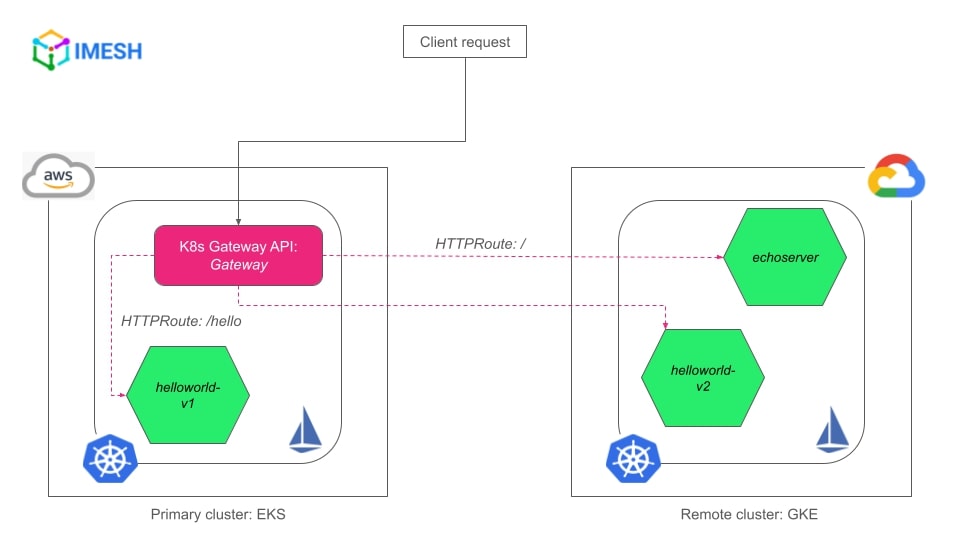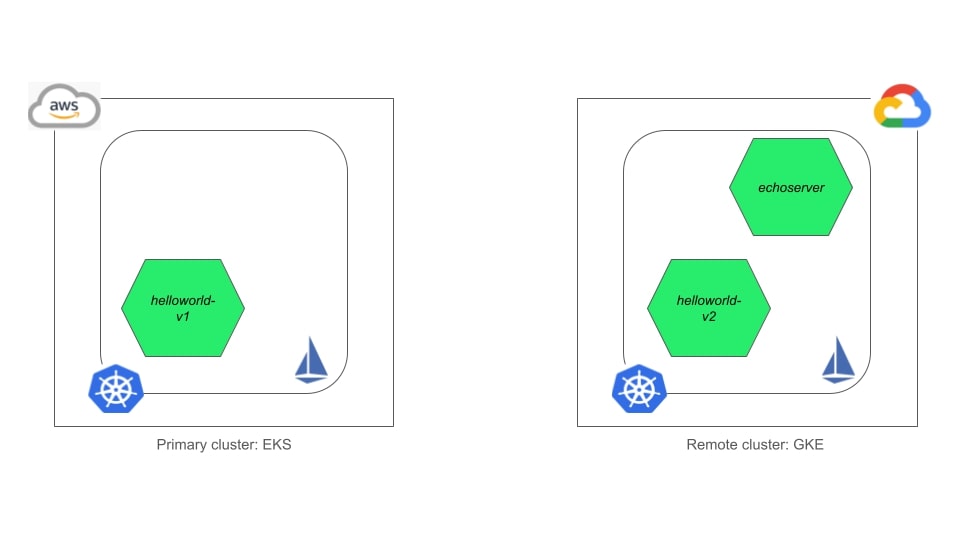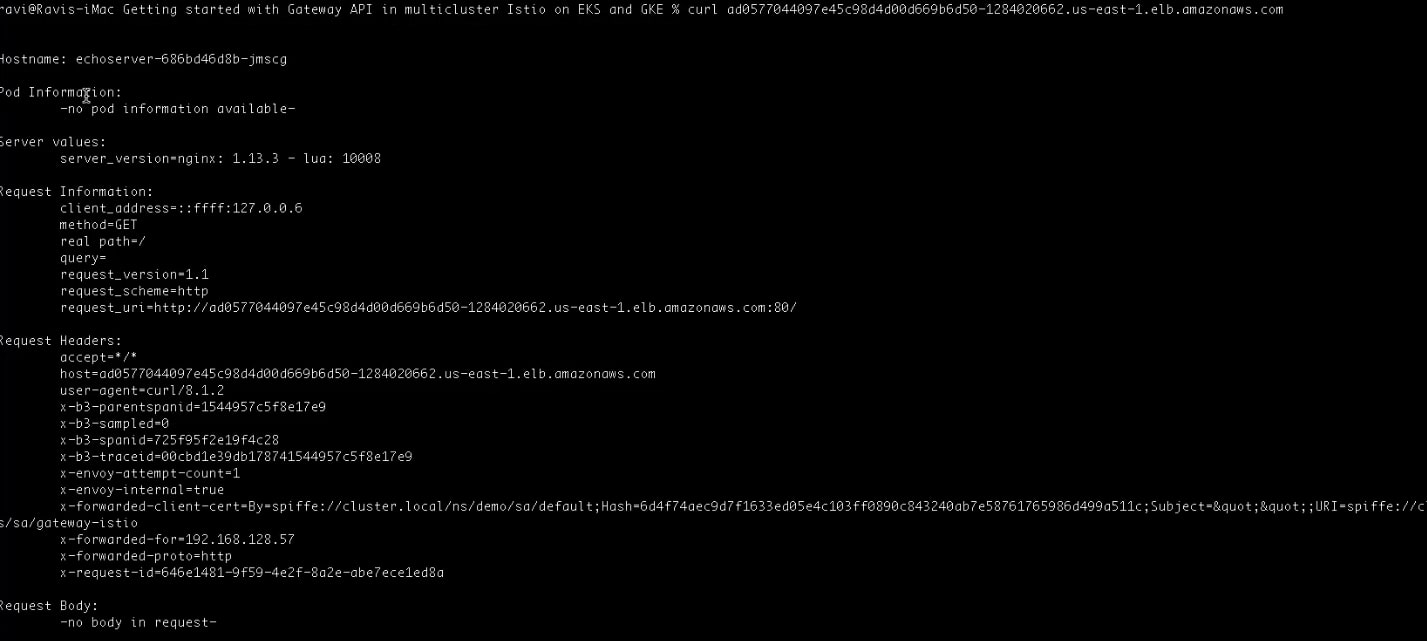Multicluster Gateways With Kubernetes Gateway API
In this article, discover how to use the Gateway API spec to configure gateways for multicluster setup.
Join the DZone community and get the full member experience.
Join For FreeKubernetes Gateway API is the new specification released by CNCF to standardize the Kubernetes Ingress traffic. Now, what if a service is configured as High Availability (HA)? (Say it is in a different cloud environment and you have to access it from the Gateway; i.e., multicluster, multi-cloud scenario.) In this article, we will showcase how to use the Gateway API spec to configure gateways for multicluster setup.
Multicluster Kubernetes Gateway Demo Overview
We have two clusters: one in EKS (primary) and the other in GKE (remote). I have deployed Istio in both the clusters and the setup is primary-remote Istio installation. Istio is used as the controller to implement the Gateway API resources.
Here’s what I’m going to do:
- In the primary cluster/EKS, deploy the
helloworld-v1deployment,helloworldservice, andechoserverservice. - In the remote cluster/GKE, deploy
helloworld-v2deployment,helloworldservice,echoserverdeployment, andechoserverservice. - Deploy the Kubernetes Gateway API resources —
GatewayandHTTPRoutes— in the primary cluster. - After the deployments, we will verify that the Gateway in the primary cluster/EKS can access the services in the remote cluster/GKE, as shown in the image below:

Multicluster, multi-cloud Gateway with K8s Gateway API demo setup
Deploy the Applications and Services in Clusters
Deploy helloworld-service in both the primary and remote clusters:
kubectl -f apply helloworld-service.yaml --context=eks-cluster
kubectl -f apply helloworld-service.yaml --context=gke-clusterkubectl -f apply helloworld-deployment-v1.yaml --context=eks-cluster
kubectl -f apply helloworld-deployment-v2.yaml --context=gke-clusterkubectl -f apply echoserver-service.yaml --context=eks-cluster
kubectl -f apply echoserver-service.yaml --context=gke-cluster
kubectl -f apply echoserver-deployment.yaml --context=gke-cluster
Note that service resources need to be deployed in both clusters for this to work. That is why I deployed the echoserver-service in the primary cluster/EKS although the deployment is only in the remote cluster/GKE.
Now, let us verify the deployments in both the primary and secondary clusters:
kubectl get svc -n demo --context=eks-cluster
kubectl get pods -n demo --context=eks-cluster
kubectl get svc -n demo --context=gke-cluster
kubectl get pods -n demo --context=gke-cluster
The primary cluster has the helloworld-v1 pod running, while the remote cluster has both helloworld-v2 and echoserver pods running successfully:

Deploy K8s Gateway API Resources and Verify Multicluster Communication
Apply the gateway resource in the primary/EKS cluster:
kubectl apply -f gateway-api-gateway.yaml --context=eks-clusterThe Gateway uses Istio as the controller and is deployed in the istio-ingress namespace.
Deploy HTTPRoute in the primary cluster for the helloworld application, which listens on path /hello:
kubectl apply -f helloworld-httproute.yaml --context=eks-clusterNow, let us verify multicluster communication by curling the helloworld application; but first, we need to get the Gateway IP:
kubectl get svc -n istio-ingress --context=eks-clustercurl your_gateway_external_ip/hello
You can see that the request is served by both the helloworld-v1 and helloworld-v2 that are deployed in the primary and secondary clusters, respectively.
Now, let us deploy the HTTPRoute for echoserver in the primary cluster, which listens on / :
kubectl apply -f echoserver-httproute.yaml --context=eks-cluster
Verify if the Gateway is able to access echoserver deployed in the remote cluster:
curl your_gateway_external_ip
The Gateway is able to get a response from echoserver deployed in the remote cluster successfully. And that is the end of the demo.
Published at DZone with permission of Ravi Verma. See the original article here.
Opinions expressed by DZone contributors are their own.

Comments